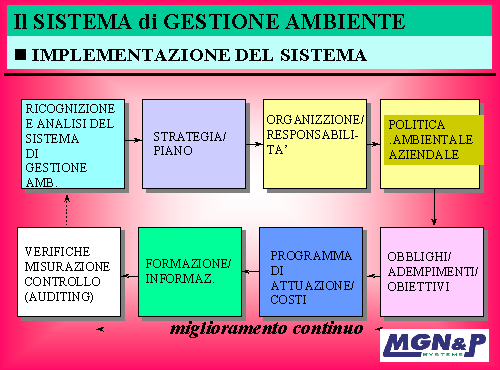The standards ISO of the series 14000 are the specifications for the Environmental Management , recognized at the international level , developed by the international committees of the ISO (International Organization for Standardization).
They constitute the benchmark of environmental quality to manage the business in the global market to support businesses .
An Environmental Management System (EMS) isolated and not integrated by the rest of the organization would not play an effective role.
The EMS is part of the overall system of company management.
ISO 14001 " Specifications for the Environmental Management System " is the heart of the Standards of the 14000 series. It lists the specifications on the basis of which a company will be assessed for environmental certification.
The ISO 14000 standard has been prepared with the intention of adopting the quality control methodologies in the environmental field (ie integrating Quality and the Environment), and with the intention of preparing a recognized standard that is generally valid for international level to avoid trade barriers.
Possible Benefits for the Company
It is spontaneous to immediately think that environmental protection can only entail costs for the company, but in reality it is a wrong way of dealing with the question of considering the realization of an environmental management system as only a factor of cost.
Without wishing to dwell on the "environmental" advantages, which in any case do not want to be neglected, there can be many benefits that can result to companies in adopting a EMS
and wanting to make a list of it would be reductive if not inappropriate, since these are in close dependence with the type of company.
That said, by way of example, we can try to summarize what could be the possible benefits for the company resulting from the adoption of the standardISO 14001:
- strengthened and documented control of compliance with the law;
- economic return from increased efficiency in the use of resources;
- greater contractual capacity (protection or increase in market shares);
- facilitation of property transactions (where the environmental factor is relevant);
- better relationships with investors, insurance companies, etc.;
- better internal relationships (workers, etc.) and external ones (local communities, etc.) to the company.
What is an Environmental Management System
The objective of an environmental management system is to define goals voluntarily to continuously improve and prevent the environmental effects of your company.
Identify the environmental effects and assess the main strengths and weaknesses of your business, from the point in legislative, technical and organizational terms, they are the first and fundamental step to build an effective and efficient system.
This first phase of analysis of environmental aspects, impacts, environmental performances and related control activities, commonly called initial environmental analysis,
consists of self-control, followed by a decision by the company management on the environmental policy that should act as a guide for planning the intervention measures.
It should always be kept in mind that environmental management systems are voluntary instruments, ie there are no regulatory provisions currently imposing them, although there are rules that establish which requirements these systems must have.
Respect for these standards becomes an essential requirement when the company decides to obtain an external recognition, ie a certification.

The Environmental Management System (EMS)
is part of the overall management system of the company : a EMS not integrated it would be difficult to play its role effectively.
The EMS can be described as the complex of :
- planned and coordinated management actions,
- operating procedures,
- documentation and registration systems,
implemented by:
- a specific organizational structure, with resources and credibility, and with defined responsibilities,
and addressed to :
- prevention of adverse effects (risks of accidents for workers, communities and the surrounding environment, production losses, waste, etc.), and
- to the promotion of activities that maintain and / or improve environmental quality .
In particular, an EMS is intended to help the company a :
- identify and evaluate the likelihood and size of risks placed on the company by environmental problems;
- assess how the business activities impact on the environment and how these can create problems for their businesses;
- define the basic principles that should guide the company's approach to its environmental responsibilities;
- establish short-term, medium-term, long-term environmental performance objectives by balancing costs and benefits;
- evaluate the resources necessary to achieve these objectives, assigning to them the relative responsibilities and establishing the consequent resources;
- elaborate specific procedures to ensure that each employee works in his activity in a way that helps to minimize or eliminate any negative impact on the company's environment;
- communicate responsibilities and instructions to the various levels of the organization and train employees for greater efficiency;
- measure the performances with reference to the prefixed standards and the objects , and make the necessary modifications;
- carry out the internal and external communication of the results achieved with the aim of motivating all the people involved towards greater results.
The definition and terms used here to describe EMS refer to the existing models applied by the most advanced companies in the environmental field, to emerging standards, capturing the aspects essential, even if from model to model the terms can take on more or less different meanings.
The main sources can be found in:
- ICC "Business Charter for Sustainable Development"
- ISO 14001
- EU regulation on ecomanagement and ecoaudit (EU EMAS Regulation)